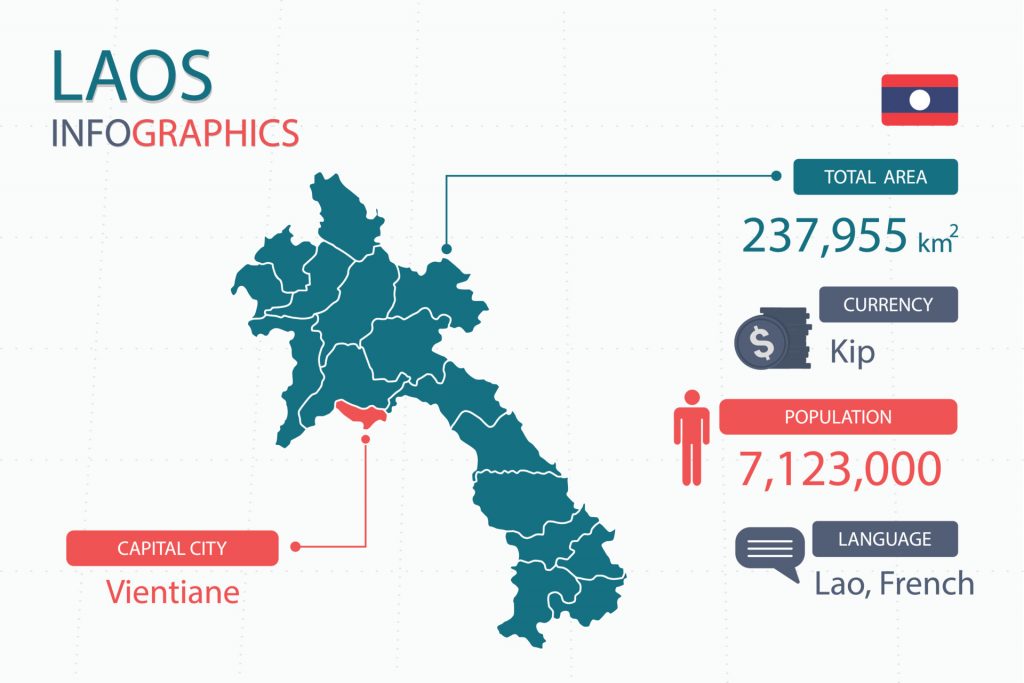The origins of the Lao Language
Lao is the official language of Laos and is also a recognized minority language in Cambodia and Thailand. It is also spoken throughout other countries in Southeast Asia as well as other locations with a Lao diaspora, such as in the United States. While it is the official language of Laos, it is also the lingua franca of the country, as many in the region speak other languages and dialects related to the official language.
VEQTA can provide a Lao Translator for a perfect translation English to Laotian or a Laos translator that translate laotian to english. Our Laos translation to english can also include English to laos writing back-translated or as required.
Lao is a tonal language and is understood to be very similar to the Thai language. Both languages are generally mutually intelligible. Other tonal languages include Vietnamese and a more common example is Chinese. This means that words that are otherwise similar can mean different things based on the melody that is given to it. Another interesting feature may be the pronoun system. Words like ‘I’, ‘you’, and ‘he/she’, in English have more variety in Lao. Firstly, ‘I’ for male and female speakers are different. Secondly, there are many versions of ‘you’, and which one to use depends on age, social status, emotions, and more. This is the same for third person pronouns ‘he’ and ‘she.’ Such differentiation is similar to other languages in the region, such as Khmer, Thai, and Vietnamese, and also of other languages in Asia such as Korean and Japanese, and reflects the areas general culture of recognizing social status and seniority.
The Lao script is an Abugida; consonants are the main components and vowels attach onto consonants to change the sound. These vowels can be written above, below, or in front of consonants. This type of system is unlike Latin scripts where vowels and consonants more-or-less play an equal role. The Lao script is derived from the Khmer script of Ancient Angkor, which is ultimately rooted in the Brahmic script, a writing system stemming from India. Compared to Thai, the Lao script has fewer duplicate sounds. In terms of numerals, Arabic numerals are commonly used. Overall, there are twenty-seven consonants in the Lao alphabet, and the consonants are also divided based on tone. Like other writing systems that are similar to Lao (as well as English), it is written from left-to-right.
However, there is also another script that is attributed to the Lao language called Thua Tham. This script is more often associated with religious literature attributed to the Buddhism in the region. This script is also used in parts of Thailand.

Both the Lao script and Thua Tham are used to write a few minority languages as well. In both these scripts, due to a lack of standardization, spelling may vary a lot within the scripts. In formal writing, there tends to be a larger amount of loan words, especially from Pali and Sanskrit.
Lao, in terms of language family, belongs to Tai-Kadai. Formal Lao writing has a considerably larger amount of loan words, especially from its Pali and Sanskrit influences, as compared to less formal writing and everyday conversation. Because of historical contexts, the Lao language has been influenced by Khmer and Thai, and vice versa. Other large influences include certain Chinese varieties, as well as French due to Laos’ colonial past. Lastly, due to the global standing of the English language, English loan words have recently come to flavor the more business and scientific vocabulary of Lao.
The history of Lao is hard to discern because of a lack of documentation, and difficult in attributing whatever documents that are available to an actual progression of Lao, or other related dialects. In general, varieties of Lao stem from the Tai-Kadai family. There has also been a heavy influence of Pali and Sanskrit, due to the prevalence of Buddhism in the country, and also from Khmer and Thai do to geographic proximity. The Tai-Kadai family itself consists of Tai from which both Thai and Lao have originated from. The people who spoke this language have roots in southern China. Scholars hypothesize that they moved south into the central Mekong valley around the 12th century CE.
During French colonial times, French also influenced the language. The language of administration and education at that time was French, and evidence of this is seen in the older population, some of which, if they were of a higher social class, still speak French, albeit with a Lao accent. French words entered the Lao vocabulary at this time, and these words still exist in the language today. However, this influence was only limited to the Lao spoken in Laos. The Lao that is spoken by Lao-speaking populations in the Northeastern Thailand, however, have not undergone this effect. In fact, the Thai language has played more of a role in terms of vocabulary in these regions due to Thailand government practices.
Since then, perhaps due to the geographic features of the country in Laos, and the languages close linguistic relationship with Thai, many dialects have developed and these are all considered Lao as they are mutually intelligible. Thus, there is no real standard even at present times, even though a standard is developing around the variety spoken in Vientiane for a few reasons. As Vientiane represents the seat of government and administration, and more importantly, where mass media is regulated, the language of that area has more sway in influencing aspects of language such as pronunciation, writing, and more.
Whether you need translate English to Laos (Laotian) and need consult with an English to Laos translator for review of your Lao Translation, VEQTA Translations can help you!
VEQTA can provide you with a perfect Lao translator for your Lao translation, English to Lao translation and Lao to english translation for the your targeted locale. Our translations to Lao are created with your target audience in mind to meet your expectations.
If you need to translate Lao – Get in touch today!
A dedicated team of Lao translators who combines Experience, Specialized Subject Matter Expertise with Translation Practices to deliver quality second to none.
Lao Subject Expertise
Lao Translators
Lao Editors
Lao Copywriters
Lao Reviewers
Lao Voice dubbing
Lao Subtitling
Lao Transcription


